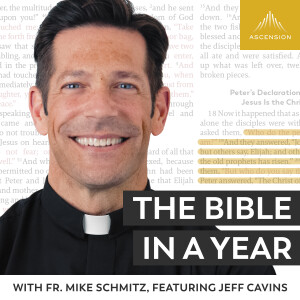

Join Tim and John as they talk about life and study John Chapter 17 Verses 1-26
Theme: https://uppbeat.io/t/northwestern/a-new-beginning
Transition Song: https://uppbeat.io/t/all-good-folks/
Introduction to John 17:1–26
This is holy ground.
John 17 gives us something no other Gospel does—a full, intimate look into the actual prayer Jesus prayed the night before the cross.
Often called the High Priestly Prayer, this chapter isn’t just a closing moment—it’s the beating heart of Jesus' mission, voiced aloud.
He prays for three things:
- For Himself—that the Father would glorify Him through the cross.
- For His disciples—that they would be protected, sanctified, and unified as they’re sent into the world.
- For us—those who would believe through their message.
Let that sink in:
You are in this prayer.
Jesus looked ahead—beyond the cross, beyond the resurrection—and saw every person who would come to know Him.
He prayed for your faith. Your unity. Your closeness to Him and to the Father.
This isn’t just a moment of reflection; it’s a moment of revelation.
We’re listening in on God the Son speaking to God the Father, with nothing hidden, nothing withheld.
Every word is soaked in love, purpose, and the longing for us to share in the glory of God.
As we enter John 17, pause and prepare your heart.
This is more than theology—it’s worship.
This is more than doctrine—it’s Jesus’ deepest desire for you.
Key Theme One: “Glorify Your Son” (vv. 1–5)
Jesus begins His prayer with eyes lifted to heaven—not downcast in defeat, but fixed on His Father in confidence.
- “The hour has come.”
This is the moment everything has been leading to. The cross is not a detour in Jesus’ mission—it’s the destination.
In it, the Son will be glorified, and through it, the Father will be glorified. - Glory through Obedience.
Jesus isn't asking for rescue; He’s asking for glory through sacrifice.
The glory of Jesus isn’t only in His power to perform miracles—but in His humility to die for sinners. - Eternal Life Defined.
Jesus gives us a clear, simple definition of eternal life:
“That they may know You, the only true God, and Jesus Christ whom You have sent.”
Eternal life isn’t just endless time—it’s a relationship.
It starts now, with knowing the Father and the Son. - Mission Accomplished.
“I glorified You on earth… I have accomplished the work You gave Me to do.”
Even before the cross, Jesus sees His obedience as complete.
He’s lived in perfect unity with the Father—everything He did pointed back to God’s glory. - A Return to Divine Glory.
Jesus now asks to return to the glory He had before the world existed—a reminder of His divine nature.
This prayer is not the cry of a mere prophet or teacher. It’s the Son of God preparing to return to His rightful place—having finished the work of redemption.
Reflection:
In these first five verses, we see Jesus’ heart:
He longs for glory—not for fame or comfort—but that the Father would be known and loved through His obedience.
That same heart should live in us: a desire to glorify God in every moment, even the painful ones.
"I have revealed You to those You gave Me out of the world. They were Yours; You gave them to Me..."
- Chosen by the Father: Jesus frames the disciples not as His personal followers but as a gift entrusted to Him by the Father. This points to divine sovereignty in salvation—God chose and gave them to the Son.
- Revelation and Response: Jesus has “manifested” the Father’s name—meaning He revealed the true nature and character of God. The disciples received this revelation with faith (v. 8), albeit imperfectly.
- Implication for Today: Discipleship begins with divine initiative. Evangelism and Christian formation are not human projects but divine responses to God’s calling and revealing work.
"I pray for them. I am not praying for the world, but for those You have given Me..."
- Focused Prayer: Jesus prays specifically for His disciples—not for the world at large in this moment, but for those who carry forward His mission. This doesn't mean the world is excluded from His love (cf. John 3:16), but that this moment is set apart for strengthening the Church.
- Unity of Glory: “All I have is Yours…” highlights the mutual indwelling between Father and Son, shared with the disciples. It’s an echo of divine unity extended toward believers.
"Holy Father, protect them by the power of Your name… so that they may be one..."
- Protection: Jesus does not ask for the disciples to be removed from danger but that they would be protected spiritually. He emphasizes God’s Name—that is, God’s authority, character, and power—as the means of preservation.
- Unity: This is not mere cooperation, but spiritual unity that reflects the oneness of the Trinity. It is rooted in shared truth, mission, and love.
- Example: During His earthly ministry, Jesus says He guarded them (v. 12), fulfilling His role as the Good Shepherd (cf. John 10). Now, He entrusts them to the Father’s continued care.
"I am coming to You now… so that they may have the full measure of My joy..."
- Full Joy in a Troubled World: Jesus connects joy not with comfort but with being rooted in the Father’s truth. It’s a spiritual joy, anchored in relationship with God, even when facing hatred and opposition.
- Rejection by the World: Because the disciples are not “of the world,” they will face hatred. This is not because of arrogance or pride but because they bear witness to a different Kingdom.
- Reflection: Many Christians today struggle to reconcile joy with hardship. Jesus shows that spiritual joy is not the absence of pain, but the presence of God's sustaining truth.
"Sanctify them by the truth; Your word is truth..."
- Not Escape, but Empowerment: Jesus doesn't ask the Father to take the disciples out of the world. He prays for sanctification—being set apart for God’s purpose while remaining engaged in the world.
- The Role of the Word: God’s Word is the means of sanctification. The truth both protects and prepares disciples for mission.
- Sent as Jesus Was Sent: Jesus says, “As You sent Me into the world, I have sent them.” This is the missional heartbeat of the prayer. Disciples are not saved to isolate but to engage and proclaim.
- Consecration through Jesus: Jesus sanctifies Himself—meaning He fully sets Himself apart in obedience to the cross—so that His disciples might also be consecrated in truth and mission.
This section teaches us the balance between:
- Intimacy with God and mission to the world
- Truth and grace
- Sanctification and sending
Jesus’ prayer is not sentimental but strategic: He intercedes for the endurance, unity, protection, and holiness of His disciples because they are the chosen instruments to carry the gospel into the world.
Application Questions- Do I see myself as “given” to Christ by the Father?
- How does God’s Word function in my life? Am I being sanctified by truth?
- In what ways am I embracing or resisting the mission to the world?
- How can I pursue deeper spiritual unity with other believers?
- What gives me lasting joy in seasons of rejection or opposition?
“My prayer is not for them alone. I pray also for those who will believe in Me through their message, that all of them may be one…”
- Forward-looking faith: Jesus envisions the entire Church—not just the apostles, but every person who comes to believe through the proclamation of the gospel.
- Unity rooted in divine oneness: The standard Jesus sets is nothing less than the unity of the Father and the Son—a mystical, spiritual unity grounded in shared truth and love.
- Purpose of unity: “So that the world may believe…” — This shows that unity is not optional. It’s missional. A divided Church obscures the gospel; a unified Church proclaims it powerfully.
Application: Do I pursue unity in the Church as a reflection of God's nature? Do I allow secondary issues to cause division?
2. The Shared Glory and Indwelling (vv. 22–23)“I have given them the glory that You gave Me… so that they may be one as We are one…”
- Glory Shared: The “glory” here is not just divine radiance but the honor, mission, and Spirit-empowered presence of Christ given to believers.
- Indwelling Love: Jesus prays that He would be “in them,” just as the Father is in Him. This highlights the mutual indwelling of the Trinity extended to believers.
- Perfected Unity: Jesus desires a complete, visible unity (“perfectly one”) to testify to the world about the love of God and the divine mission of Christ.
Theological Note: This prayer destroys any shallow, superficial vision of Christianity. It calls for deep, spiritual union rooted in the love and life of God Himself.
- A Desire for Eternal Fellowship (v. 24)
“Father, I want those You have given Me to be with Me where I am, and to see My glory…”
- Heavenly Longing: Jesus desires not just the obedience of believers, but their presence—He wants us with Him. This is not merely a request; it’s an expression of deep love.
- Beholding Glory: Heaven is defined not merely by paradise, but by seeing and enjoying the glory of Christ. This echoes Moses’ plea in Exodus 33:18: “Show me Your glory.”
💡 Reflection: Do I think of salvation primarily as “escape from hell,” or as entering into glorious communion with Christ forever?
4. The Eternal Love of God (vv. 25–26)“Righteous Father… I have made You known to them… in order that the love You have for Me may be in them…”
- God’s Righteousness & Relationship: Jesus closes by addressing the Father as “Righteous”—highlighting that God's holiness is not in conflict with His love.
- Love Transferred: Jesus prays that the same love the Father has for the Son would live in believers. This is staggering. The divine love shared eternally in the Trinity now dwells in us.
- Ongoing Revelation: “I will continue to make You known…” Jesus’ work of revelation continues through the Spirit, the Word, and the Church.
Core Truth: The Christian life is not just about behavior—it’s about being indwelled by divine love and shaped by the ongoing revelation of the Father through the Son.
Summary of Key InsightsVerse Range
Theme
Core Insight
vv. 20–21
Prayer for Future Believers
Unity is the strongest witness to the truth of the gospel.
vv. 22–23
Shared Glory & Indwelling
Believers are drawn into the divine fellowship of the Trinity.
v. 24
Jesus' Desire for Us
Christ wants to be with us—heaven is relational.
vv. 25–26
Love and Revelation
God's eternal love is placed within us as Jesus continues revealing the Father.
Application Questions
- How can I contribute to deeper unity within my church or Christian community?
- Do I experience Christ’s glory and presence as a daily reality—or just as a future hope?
- How can I reflect the divine love of the Father to others?
- What does it mean to be “in Christ” and to have Him “in me”? How should that shape my identity?
John 17 stands as one of the most sacred and intimate moments in all of Scripture. It is the longest recorded prayer of Jesus and offers a unique window into His heart just before the cross. This is not a public sermon or a private meditation—it is a divine conversation between the Son and the Father, and we are invited to listen in.
1. Jesus as Our Perfect IntercessorThroughout the chapter, Jesus functions in His role as High Priest, interceding first for Himself (vv. 1–5), then for His immediate disciples (vv. 6–19), and finally for all future believers (vv. 20–26). In doing so, He models:
- Reverent intimacy: He addresses God as “Father” throughout, showing both deep familiarity and holy reverence.
- Selfless purpose: Even when He prays for His own glorification, it’s so “the Son may glorify the Father” (v. 1).
- Ongoing advocacy: This prayer previews the ongoing intercessory ministry of Jesus, who "always lives to make intercession" for His people (Hebrews 7:25).
Section
Theme
What We Learn
vv. 1–5
Glorify Your Son
Christ’s obedience and mission are part of God's eternal plan for redemption.
vv. 6–19
Sanctify Your Disciples
Christ’s followers are set apart in truth for mission, protected by His name.
vv. 20–26
Unite and Indwell All Believers
The love and unity of the Trinity are extended to us through Jesus.
This prayer is rich in Trinitarian theology, missional focus, and covenantal love. Jesus is not merely summarizing His ministry—He is consecrating the Church for what is to come.
3. Love and Glory at the HeartIf John 17 had a refrain, it would be love and glory:
- Jesus speaks of the glory He had with the Father before the world began (v. 5) and prays that believers will one day see His glory (v. 24).
- The love of the Father for the Son becomes the love that dwells in us (v. 26).
This is the heart of the Christian faith: being drawn into the eternal love and glory shared by the Triune God.
4. Application: Living in the Answer to Jesus’ PrayerJohn 17 isn't just history—it is prophecy and present reality. Jesus' prayer continues to shape the Church:
- When we walk in unity, we reflect His prayer for oneness.
- When we live sanctified in the truth, we answer His call to holiness.
- When we abide in love, we fulfill His deepest longing for His people.
We are called not merely to admire this prayer, but to live inside it.
Closing ReflectionJohn 17 is a sacred moment. Jesus, standing at the threshold of His suffering, does not pray for escape, vengeance, or relief—but for glory, truth, unity, and love. He looks through time and sees you. And He prays that you would know the Father, be kept in the truth, and be filled with divine love.
This is not only the conclusion of a chapter—it's the final heartbeat of Christ’s public ministry before Gethsemane. And it sets the stage for the cross, where the prayer of John 17 begins to be fulfilled through the self-giving love of the Son of God.
More Episodes
All Episodes>>You may also like
Create Your Podcast In Minutes
- Full-featured podcast site
- Unlimited storage and bandwidth
- Comprehensive podcast stats
- Distribute to Apple Podcasts, Spotify, and more
- Make money with your podcast












